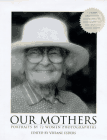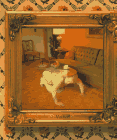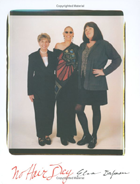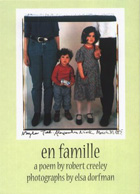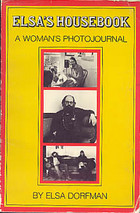Our Mothers, review by Elsa Dorfman
Mother. Judy Olausen. Penguin Books. no pp.
At the same time that the photography art scene is obsessed with the offbeat, the weird, the body pierced, there is a parallel track that is interested in the family, construed traditionally or loosely–as friends, partners, colleagues, children. (The early work of Nan Goldin merged both fascinations: the offbeat AND the family. Sally Mann’s work merges the family and emerging sexuality.)
Photography books about women–as mothers, daughters, sisters — have been in the air for a few years. Aperture did a very nice issue (and book) on mothers and daughters in the early 1990s. Doubleday did an interesting book of portraits of famous women and their children by Barbra Waltz and interviews by Jill Barber in 1987. And perhaps the best known of this genre is Sisters, with essays by Carol Saline and photographs by Sharon J. Wohlmuth. Published by Running Press, their book was on the best seller list for ages.
So it is no surprise that this season brings three books about mothers. Or that two of the books have image AND text. Short essays adapted from interviews with the subjects seem to be an essential component in these books about relationships. Even when the pictures are very strong, the photographer wants to tell us MORE about the people than is revealed in the image. And the viewer wants to know MORE — having been intrigued by the image. Everyone is curious about someone elses family and friends. The texts in Viviane Esders’ book Our Mothers and Mariana Cook’s book,Mothers and Sons are the reasons these book work.
Implicit in this genre about family are “warm fuzzy feelings.” These books are subtley reassuring. The people in the photographs all like each other. The books project a feeling of well being: the world works. Don’t worry. Out there are loving families, people who like eachother. People who can tell cute anecdotes about eachother. It happens. That is part of their attraction. There is no sense of HATE or RESENTMENT or ALIENATION. That makes sense. When the photographer calls and asks, would you pose with your mom, the people who aren’t into their families, pass on the invitation.
And the books are designed to satiate our curiosity. So that’s what Ruth Bader Ginsburg’s son looks like. Joyce Tenneson’s mother was a twin. Mary Ellen Mark’s mother died at a relatively early age. Robin Williams looks just like his mother Laurie. To her credit, Esders has included some work with an edge.
Viviane Esders, a noted French editor and gallery dealer, invited over seventy women photographers (mostly French and American) to submit their favorite photograph of their mom, hopefully, but not necessarily, one that they had made. She also asked each woman to write about their mothers, their relationship, and their affection. It sounds simple enough and pretty obvious. What is surprising is the power of the book and its charm. Each woman sent Esders a thumbnail portrait or snapshots of herself (a nice touch), her signature ( some careful and methodical, some scrawlled) and a short useful biographical paragraph.
Rossella Bellusci took the opportunity to photograph her mother especially for the book, but most had already made a portrait that was important to them. Melissa Shook, Joyce Tenneson, and Ariane Lopez-Huici, whose mothers had died at an early age, submitted cherished family photographs. Their texts describe their loss. Deidi von Schaewen created a collage of her mother’s life.
The short foreward by Kathy Ryan is a model of what an introduction should be. It is CLEAR, not so common in photography books these days, to the point, and draws the connection between these images and the pull of family albums. ” This book is like an old carton at the flea market where family memories live. But only mothers are here. And we know who took the pictures and wrote the words. We see here daughters struggle to render their mothers truthfully. ..There is much to recognize and be touched by in the family albums of other people.” p.7
Viviene Esders in her introduction writes of the mandate she gave the women: the confrontation of a daughter in front of her mother. “Taking a formal portrait is not like taking a snapshot at a family gathering. Does one have the courage to face one’s own mother, to sustain her gaze, to adjust the camera, and to examine her face at such close range? ” p.8 Esders notes that some women demurred when they got her invitation to participate, saying, ” I cannot photograph my mother.” Others worried that they couldn’t make a GOOD ENOUGH photograph of their mother. Good enough for whom Esders wonders. Wrote Carole Bellaiche, ” My mother has red hair and green eyes. It ws the first problem I had to confront when I took her photograph. How could I make all these lovely colors come through?” p. 29. And sometimes it was the mothers who didn’t like the lense of their daughters. Ekaterina Golitsyna writes ” My mother is too humble to allow her presence to dominate a photograph. She is afraid of the intimacy of the lens. p. 60.
Wrote Jane Evelyn Atwood about her portrait of her mother:”My mother doesn’t really like to be photographed. This photo of her was one of my father’s favorites.” p.23 None of the women took the assignment casually. Wrote Francoise Janicot,” My mother had an imperceptible quality. I was not able, even at a very high speed, to photograph her. So I drew her portrait, probably with the help of a passport photograph and from memory…p.71
Yvette Troispoux, Emily Anderson, Paolo Agosti and Aliza Auerbach contend with their mothers old age and fragility in their text. Writes Auerbach,” I remember my mother toweling me after a bath, taking particular care with each little finger, separating them with a gentle touch in order to dry them without causing any harm. And now, here I am, giving my fragile old mother a bath, drying her as gently as I can, for she is so vulnerable, her body so breakable,her skin so tansparent. p. 24.
Though the dominant tone of the book is affectionate, Nathalie van Doxell, Cuchi White,Claude Alexandre,Jane Evelyn Atwood, and Nan Goldin, are not shy in discussng the conflicts and tensions of their relationships. Dominique Auerbacher’s images are from her 1993 video, Ma Crotte en Chocolat. Her text reads like a monologue,”You’re too headstrong. You do whatever suits you. If only it were possible to speak to you. You don’t know what you want. Some day you’ll be sorry, but it’ll be too late then. Don’t say I didnt warn you. I don’t know who you take after, but it’s not me. You have a hard voice and a wicked stare”…p.27
And stare they do, these photographer daughters. Many of the images are strong portraits that hold their own as images. Especially notable are Barbara Alpers nude self-portrait of her and her mom, Annie Leibovitz’s portrait of her parents on their fiftieth anniversary, Sylvia Plachy’s portrait of her mom after her father’s funeral, Barbara Kasten’s picture of her mother in Lithuania and Dolores Marat’s portrait of her mother naked.
Esders’ collection is unassumming and wonderful. No self important or grandiose design here–the photographers are presented in alphabetical order. Esders Gallic sensibility and acumen strikes just the right balance between text and image. She elicited warm and thoughtful short essays from the photographers. There is a lot of heart in this book. I loved it.
Mother by Judy Olausen.
Coming off of Esder’s book, Mother by Judy Olausen, seems more weird than it might otherwise. It is a series of portraits of the photographer’s 74 year old mother Vivien in VERY odd poses. The images are sort of Cindy Sherman meets I Remember Mama. Or as Eugenia Parry said to me, “Mama meets Wegman.” It’s true. Olausen does to her mother what Wegman does to his dogs. Only Wegman is more gentle with his subject.
” I wanted to tell the story of what it was like to be a woman in the 1950s. A woman had virtually no career opportunities, except perhaps as a secretary or a nurse. I wanted younger women to see how far we’ve come– and to see that we didn’t always have the options we have now.” Huh? What does that mission have to do with the scenarios Olausen conjured up for her mom? Vivien pretending to be a coffee table? Vivien lying on the side of the road? Hanging by clothespins on a clothesline? Dragging a huge crossover her shoulder in the supermarket? Some images are quick guffaws and would be successful in a calendar. One of the best ones shows Vivien holding an empty picture frame in front of her house. But the house–not Vivien–is seen through the emtpy frame she is holding. A computer trick has made Vivien become her house. Another humorous image has Vivien decked out in leopard: the hat, the scarf, the gloves, the coat, the skirt, even eye glass frames, in front of a leopardskin wall It’s titled “Mother in Camouflage”, but I don’t know what it has to do with political statements. Another image has innocent Vivien in a fur coat at the bottom of a hill gazing off into the future as a giant stuffed turantula approaches. “Don’t look back,” Olausen calls it. And of course Olausen has Vivien walking on water. Without a doubt Vivien is the worlds most obliging model –and MOTHER> She should be doing commercials. Or she and Olausen should have their own TV show.
Mothers and Sons by Mariana Cook has some wonderful photographs of women with their sons –and some interesting essays by the participants. Standout portraits are of Anne Lamott, Leah Adler, Emily Otis Barnes, Ruth Bader Ginsburg, Nora Atlas, Laurie Williams, Alexandra Cross, Paula Kissinger. Fera Levitas and Rildia Bee O’Bryan Cliburn.
What makes the pictures work are the resemblances and the visible comfort the adult children and moms have with eachother. A few look uncomfortable with the camera, not with the mom. The lighting is made to flatter;its flatness erases all the wrinkles and lines in her subjects. Cook has a friendly eye. She isn’t doing a hatchet job on her subjects. She isn’t trying to expose them or lay bare their characters. Their personalities prevail and we get a hint of what drives them. The black background is austere and because of the way the book is printed it often dominates the image.
Alas, Cook was sloppy about the essays. She let a lot of mothers and a lot of sons off the hook. Not a word from Roger W. Straus III. Christian Tual. Marian Wright Edelman. When I read what Guy Cross wrote about his mother, I was disappointed that she didn’t have her say. ” it was only at the very end of her life…that she thought that I had ” succeeded”….I was with her the night beforeshe died. …I asked her if she was still woried about me. She said, ” No. I am not worried anymore.” Then she touched my face with her hand and looked at me for a long time. She died the next day at high noon. Just like her. Bye Mom. And thanks. p.86
Bella Pasternak is photographed with her three sons. Her essay is great,but not a word from the boys. From their look in their portrait it seems each of them would have written something interesting and different one from the other. “I came to America by boat and met my husband in 1952 at a Purim party. I told him marriage is a fifty-fifty arrangement. “As long as you relinquish your fifty percent we’ll have no problems.”I said. Now after forty years, he says he wants to renegotiate the contract and get back some of his rights…I’ll think about it. My children are my life…My sons all have some of my stubborness and determnation. They are all successful lawyers. I wanted to be a lawyer when I was young. Now I’m proud to say I’ve got three of my own. p.52. Cook uses the portraits, both wonderful, of Van Cliburn and his mom and Katherine Graham and her son without any commentary. Too bad she couldn’t have managed short phone interviews with each of them. I can see why she printed the portraits even if it ruined the symmetry in her book.
The portraits of women with their young sons tend to be competent images but just not as interesting or quirky as the portraits of the adult pairs. The text by the little boys are gushy valentines to mom and basically a waste. Cook would have had a much more interesting book if she stuck to women with sons over seventeen.
Cook’s reason for collecting her pairs isn’t always obvious. Clearly, she went after the famous pairs, e.g., Virginia Clinton Kelley and Bill Clinton. But then what? The book has a slight air of social climbing. As if all the people are important and, if we were anyone, we would know who these people are. The choices may be regional celebrities of a sort. If we lived in New Mexico or California, New York maybe we would know who a couple of them were. Identifying paragraphs about who the pairs are and what they do at the end of the book would have been helpful. f
Both Esders and Cook count on creating an air of familiarity and intimacy with their subjects. It isn’t quite the same intimacy we see on television, in personal profiles and interviews. But the need for intimacy with others and the urge to share intimate relationships seems to be part of the culture these books come out of. Olausen’s book fails partly because it is cold. We cringe at what she asks her mother to do. Also, both Esders and Cook capitalize on our fascination with celebrities, even minor local celebrities.( If the people aren’t REALLY celebrities, they SEEM like celebrities and are treated/presented by the authors AS celebrities. Who are we to know the difference?). Olausen is sensitive to the need for celebrity in her book and tries witlessly to make her mother into a celebrity. Treating your subjects as if they were famous is essential to this genre.



